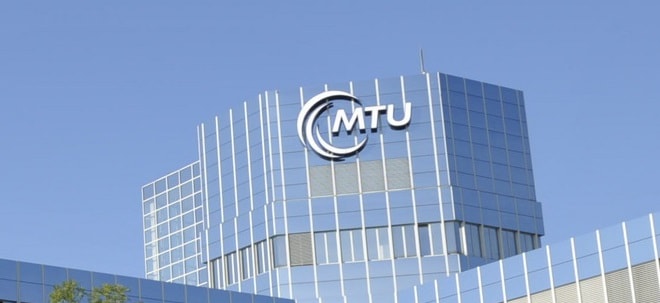Why Is Oracle (ORCL) Down 8.8% Since Last Earnings Report?
Werte in diesem Artikel
It has been about a month since the last earnings report for Oracle (ORCL). Shares have lost about 8.8% in that time frame, underperforming the S&P 500.Will the recent negative trend continue leading up to its next earnings release, or is Oracle due for a breakout? Before we dive into how investors and analysts have reacted as of late, let's take a quick look at the most recent earnings report in order to get a better handle on the important drivers. Oracle Q2 Earnings Miss Estimates, Revenues Increase Y/YOracle (ORCL) reported second-quarter fiscal 2025 non-GAAP earnings of $1.47 per share, which missed the Zacks Consensus Estimate by 0.68% and increased 9.7% year over year in both USD and constant currency (cc).Revenues rose 9% (in USD and cc) year over year to $14.1 billion, driven by continued momentum from its Oracle Cloud Infrastructure (“OCI”) business, including from winning cloud-computing contracts from AI-focused startups. The figure missed the Zacks Consensus Estimate by 0.46%, disappointing investors who have boosted the stock to a record high in recent weeks on enthusiasm for the company’s ascendant cloud business. Shares of the company lost about 7% in extended trading after closing at $190.45. Oracle has long tried to find its footing in the lucrative industry of renting computing power and storage, which is dominated by much larger rivals led by Amazon Web Services and Microsoft. The recent success has been fueled by demand from artificial intelligence companies seeking to train their models and marquee customers like Uber Technologies and ByteDance Ltd.’s TikTok. Revenues from the Americas increased 10.7% year over year to $8.93 billion and accounted for 63.5% of total revenues. Europe/Middle East/Africa climbed 6.7% year over year to $3.38 billion and contributed 24% of total revenues. The remaining revenues came from Asia Pacific, which increased 0.2% year over year to $1.7 billion.Top-Line DetailsCloud services and license support revenues increased 12% year over year and in cc to $10.8 billion, driven by strategic cloud applications, autonomous database and OCI. Cloud license and on-premise license revenues inched up 1% year over year (3% at cc) to $1.19 billion. Total cloud revenues (SaaS plus IaaS) were up 24% in both USD and cc at $5.9 billion. Cloud Infrastructure (IaaS) revenues came in at $2.4 billion, up 52% year over year and at cc. Cloud Application (SaaS) revenues of $3.5 billion increased 10% year over year and at cc.Fusion Cloud ERP (SaaS) revenues came in at $0.9 billion, up 18% year over year and at cc. NetSuite Cloud ERP (SaaS) revenues of $0.9 billion increased 20% year over year and 19% at cc. Hardware revenues were $728 million, down 4% year over year (down 3% in cc). Services revenues decreased 3% (down 3% at cc) to $1.33 billion.Oracle is currently live in 17 cloud regions with database-at-cloud services and has another 35 planned with Azure, Google and AWS. Database subscription services, which include database license support, were up 5%. Application subscription revenues, which include product support, were $4.8 billion, up 7% year over year. The company’s strategic back-office SaaS applications now have annualized revenues of $8.4 billion and were up 18%. Infrastructure subscription revenues, which include license support, were $5.8 billion and up 14%. Software license revenues were up 3% to $1.2 billion, including Java, which saw excellent growth.Infrastructure subscription revenues, which include license support were $6 billion, up 17%. Record level AI demand drove Oracle Cloud Infrastructure revenues, which increased 52%. Excluding legacy hosting infrastructure, cloud services revenues were up 55%. Infrastructure cloud services now have annualized revenues of $9.7 billion.OCI consumption revenues were up 58% as demand continued to outstrip supply. Growth in the AI segment of the infrastructure business was extraordinary. GPU consumption was up 336% in the quarter. ORCL delivered the world's largest and fastest AI supercomputer, scaling up to 65,000 Nvidia H200 GPUs.Operating Details of OracleThe non-GAAP total operating expenses increased 8% year over year and in cc to $7.96 billion.The non-GAAP operating income was $6.09 billion, up 10% year over year and at cc. The non-GAAP operating margin was 43%, which expanded 58 basis points on a year-over-year basis.ORCL’s Balance Sheet & Cash FlowAs of Nov. 30, 2024, Oracle had cash & cash equivalents and marketable securities of $11.3 billion compared with $10.9 billion as of Aug. 31, 2024.Operating cash flow and free cash flow amounted to $20.2 billion and $9.54 billion, respectively.The company’s remaining performance obligation (RPO) is more than $97.3 billion, up 50% at constant currency, reflecting the growing trend of customers wanting larger and longer contracts as they see firsthand how Oracle Cloud Services are benefiting their businesses. Cloud RPO grew more than 80% and now represents nearly three-fourths of total RPO. Roughly 39% of total RPO is expected to be recognized as revenues over the next 12 months.The company purchased 1 million shares for a total of $150 million. The board of directors declared a quarterly cash dividend of 40 cents per share of outstanding common stock.GuidanceFor the second quarter of fiscal 2025, total revenues are expected to grow in the band of 9-11% in constant currency and between 7% and 9% in USD at today's exchange rate. Total cloud revenues are expected to grow in the range of 25-27% at constant currency and 23-25% in USD.Non-GAAP EPS is expected to grow in the band of 7-9% and be between $1.50 and $1.54 in constant currency. Non-GAAP EPS is expected to grow in the range of 4-6% and be between $1.47 and $1.41 in USD.The company expects cloud revenues to reach $25 billion in fiscal 2025.How Have Estimates Been Moving Since Then?In the past month, investors have witnessed a downward trend in estimates revision.The consensus estimate has shifted -5.76% due to these changes.VGM ScoresCurrently, Oracle has a subpar Growth Score of D, though it is lagging a bit on the Momentum Score front with an F. Charting a somewhat similar path, the stock was allocated a grade of D on the value side, putting it in the bottom 40% for this investment strategy.Overall, the stock has an aggregate VGM Score of F. If you aren't focused on one strategy, this score is the one you should be interested in.OutlookEstimates have been broadly trending downward for the stock, and the magnitude of these revisions indicates a downward shift. Notably, Oracle has a Zacks Rank #3 (Hold). We expect an in-line return from the stock in the next few months.7 Best Stocks for the Next 30 DaysJust released: Experts distill 7 elite stocks from the current list of 220 Zacks Rank #1 Strong Buys. They deem these tickers "Most Likely for Early Price Pops."Since 1988, the full list has beaten the market more than 2X over with an average gain of +24.1% per year. So be sure to give these hand picked 7 your immediate attention. See them now >>Want the latest recommendations from Zacks Investment Research? Today, you can download 7 Best Stocks for the Next 30 Days. Click to get this free report Oracle Corporation (ORCL): Free Stock Analysis ReportTo read this article on Zacks.com click here.Zacks Investment ResearchWeiter zum vollständigen Artikel bei Zacks
Ausgewählte Hebelprodukte auf Oracle
Mit Knock-outs können spekulative Anleger überproportional an Kursbewegungen partizipieren. Wählen Sie einfach den gewünschten Hebel und wir zeigen Ihnen passende Open-End Produkte auf Oracle
Der Hebel muss zwischen 2 und 20 liegen
| Name | Hebel | KO | Emittent |
|---|
| Name | Hebel | KO | Emittent |
|---|
Quelle: Zacks
Nachrichten zu Oracle Corp.
Analysen zu Oracle Corp.
| Datum | Rating | Analyst | |
|---|---|---|---|
| 27.01.2025 | Oracle Buy | Jefferies & Company Inc. | |
| 03.01.2025 | Oracle Sector Perform | RBC Capital Markets | |
| 10.12.2024 | Oracle Hold | Joh. Berenberg, Gossler & Co. KG (Berenberg Bank) | |
| 10.12.2024 | Oracle Sector Perform | RBC Capital Markets | |
| 10.12.2024 | Oracle Neutral | JP Morgan Chase & Co. |
| Datum | Rating | Analyst | |
|---|---|---|---|
| 27.01.2025 | Oracle Buy | Jefferies & Company Inc. | |
| 10.12.2024 | Oracle Buy | UBS AG | |
| 10.12.2024 | Oracle Buy | Jefferies & Company Inc. | |
| 05.12.2024 | Oracle Buy | Jefferies & Company Inc. | |
| 30.09.2024 | Oracle Kaufen | DZ BANK |
| Datum | Rating | Analyst | |
|---|---|---|---|
| 03.01.2025 | Oracle Sector Perform | RBC Capital Markets | |
| 10.12.2024 | Oracle Hold | Joh. Berenberg, Gossler & Co. KG (Berenberg Bank) | |
| 10.12.2024 | Oracle Sector Perform | RBC Capital Markets | |
| 10.12.2024 | Oracle Neutral | JP Morgan Chase & Co. | |
| 23.10.2024 | Oracle Sector Perform | RBC Capital Markets |
| Datum | Rating | Analyst | |
|---|---|---|---|
| 13.12.2022 | Oracle Sell | Goldman Sachs Group Inc. | |
| 21.10.2022 | Oracle Sell | Goldman Sachs Group Inc. | |
| 19.03.2019 | Oracle Verkaufen | DZ BANK | |
| 17.09.2015 | Oracle Sell | Joh. Berenberg, Gossler & Co. KG (Berenberg Bank) | |
| 08.01.2015 | Oracle Sell | Joh. Berenberg, Gossler & Co. KG (Berenberg Bank) |
Um die Übersicht zu verbessern, haben Sie die Möglichkeit, die Analysen für Oracle Corp. nach folgenden Kriterien zu filtern.
Alle: Alle Empfehlungen


